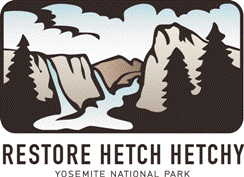Loving
Yosemite means many things ... like loving reliable water deliveries as well
For many of us, loving Yosemite means loving the whole park and
therefore restoring Hetch Hetchy Valley to its former glory. And restoring
Hetch Hetchy Valley means developing a practical water system solution for San
Francisco and its Bay Area customers. So Restore Hetch Hetchy loves a reliable
water system as well.
We have always emphasized that San Francisco can and should
continue diversions of high quality Tuolumne River water. We just don't want
the city to store the water within the boundaries of Yosemite. Analysis
shows that 95% of the Tuolumne River supplies now diverted to San Francisco
would still be available after Hetch Hetchy Valley is restored.
So we are scratching our heads over the recent news that another
critical piece of San Francisco's infrastructure is at risk. As the SF Examiner
reports, the Mountain Tunnel could
collapse and is in need of a $M 628 repair. The Mountain Tunnel is just one of five principal tunnels through which Tuolumne River diversions flow
enroute from the Sierra to the Bay Area (see diagram).
Restore Hetch Hetchy supports repair of this critical infrastructure
- as we did a decade ago when the Irvington Tunnel was shown to be at risk.
But we also question whether this latest revelation is yet another reason
why San Francisco (as well as other urban communities) should question the
wisdom of relying on a single remote source for the majority of its water. Last
summer's "Rim Fire" made us ask the same question.
Diversity is reliability. Water systems of the future will
increasingly develop local supplies - by better managing groundwater, recycling
wastewater, capturing storm water and storing supplies closer to their
customers.
We hope San Francisco will soon support restoration of Yosemite's
Hetch Hetchy Valley, and will diversify its system as well to increase reliability.
But meanwhile, we support a timely and cost-effective solution to the problems
with the Mountain Tunnel.
Spreck Rosekrans is
Executive Director of Restore Hetch Hetchy



